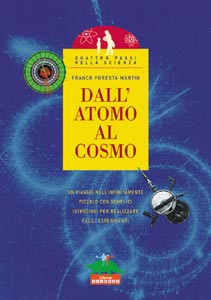by Franco Foresta Martin, Editoriale Scienza. ISBN 8873072305, €12.90.

From the title it might seem that this book is a scientific voyage from the infinitely small to the infinitely large, but in fact it’s more like a historic trip from the origin of science to today’s research in particle physics. From the Greek philosophers to the Standard Model, it introduces the reader to the most important contributors to today’s physical description of the constituents of matter. Although cosmology and astrophysics are not discussed, the book explores the history of particle physics in 12 chapters. It chronologically presents the most important challenges and breakthroughs, and includes some fascinating anecdotes, which make reading the book more pleasant.
The layout of the book looks inviting, especially (in the reviewer’s opinion) for a younger audience, and no formulae are used. Simple experiments presented at the end of almost every chapter can be easily performed at home or at school. The book is produced in collaboration with the Italian National Institute for Nuclear Physics (INFN), which is distributing it free to schools in Italy. The final chapter describes the activities of the INFN and thereby shows how Italian researchers contribute to physics. In this way, students are informed about the opportunities they can expect if they study physics at university.
The author, Franco Foresta Martin, is a well known science journalist and popularizer. His personal experience as a writer, as well as good scientific accuracy, come out throughout the book. However, it is not clear whether the historic approach and the (often too?) simple experiments can be really effective with today’s young people, in the era of the Internet and high technology. Sometimes the difficulty in finding the right level of explanation is particularly apparent, as the reader can easily get lost between the history and life of the scientists and some of the deep notions of the physics they performed. The chapter on radioactivity shows this very well: Rutherford’s theory about atoms is introduced at the same time as ions and natural radioactivity. On the other hand, the experiment proposed at the end of the same chapter – radioactivity seen on a TV screen – seems potentially more tailored to today’s young generation, and therefore more appropriate.
The “Quarkoscopio”, or quarkoscope, is the activity proposed at the end of the last chapter, which is about the Standard Model and the use of fundamental particles in medicine. With this simple instrument, which can be built using cardboard, one can easily find out the quark constituents of the most common particles. The quarkoscope is quite an original idea and could turn out to be useful even to more experienced physicists!








